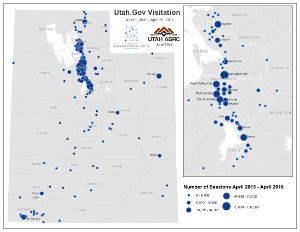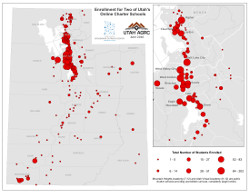This month’s maps explore two important areas that illustrate the important goal of having all Utah communities equipped with high speed broadband service.
The first maps look at usage patterns for online government services and information that is accessed directly from the main utah.gov website. The second set of maps depict the distribution of education enrollment for students attending virtual charter schools where the curriculum is taught entirely online.
Utah.gov visitation
Since the first online government service was offered in 1999, over 1,000 services have been added. Today Utah residents can use the internet to access a great variety of services, including those related to birth certificates, vehicle registration, business licensing, tax filing, hunting licenses, voter registration, job applications, and even ordering death certificates.
A recent study demonstrated significant savings for online services with the average service costing $13 more per transaction when online options are not used. An analysis of 9 major state government services concluded that $46 million was saved over 5 years by providing services online.
The first maps for this month show data derived from the Google Analytics service that monitors the utah.gov website and approximates usage, grouped by Google’s list of communities, for the period between April 2015 through April 2016. These maps demonstrate the use of online government services accessed from utah.gov is prevalent in both urban and rural areas.
Utah Virtual Charter schools
Utah has several public charter schools that serve students exclusively through curricula delivered online, via high speed internet. These programs provides an alternative path toward learning and achievement for parents and students located anywhere with a capable internet connection.
The Broadband Outreach center was able to obtain the generalized community locations of students from two all-online charter schools: Utah Virtual Academy (serving K-12) and Mountain Heights (serving grades 7-12). Together, these two charter schools serve over 2469 students around the state!
Similar to the use of utah.gov, the distribution of virtual education enrollment is representative of population density across Utah. Many of the students are from urban areas, but as 28 of 29 counties have enrollees in one of these schools, there is a significant enrollment from rural areas as well. The second map looks at demographics, by comparing the number of enrolled students in these two schools to the average (mean) county age.
The results of these brief analyses show clearly that high speed internet service is providing great efficiencies and opportunities to residents across the entire state. Focusing on sustaining accessibility to broadband and enhancing existing service, including in Utah’s relatively few underserved areas, will ensure that Utah communities are best prepared to fend off the threat of ‘digital divide’.

